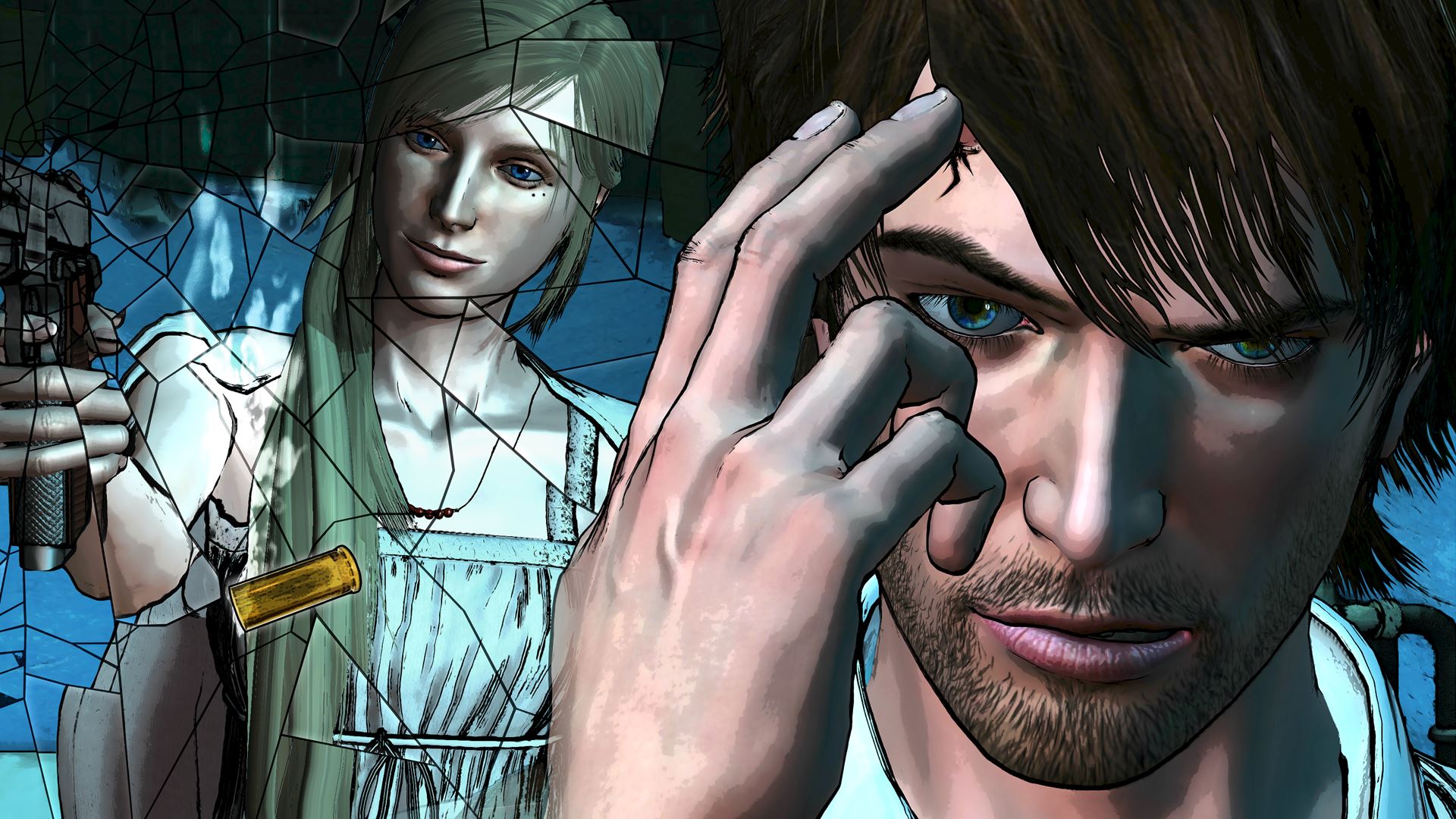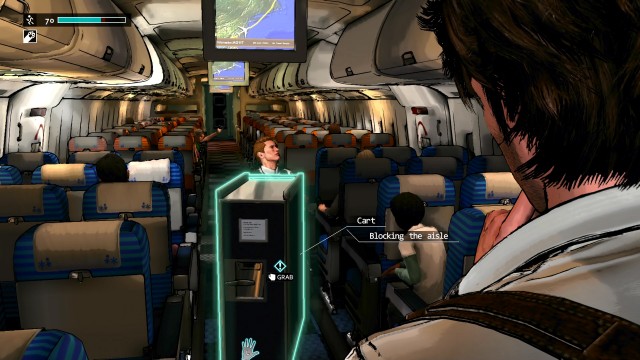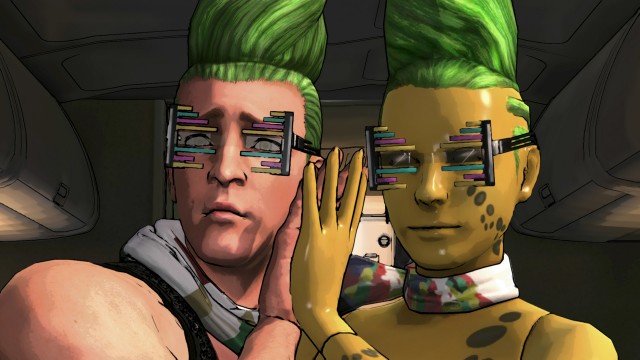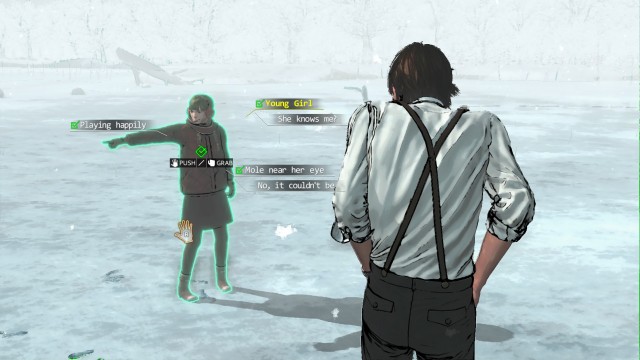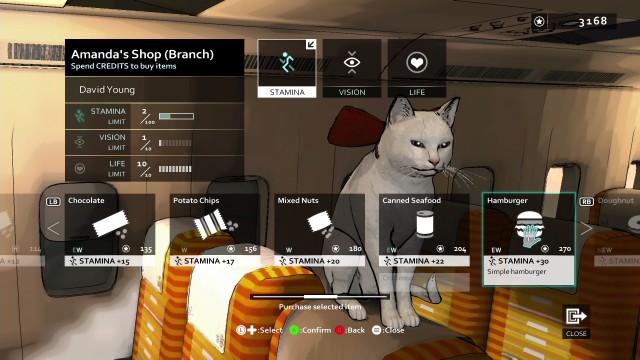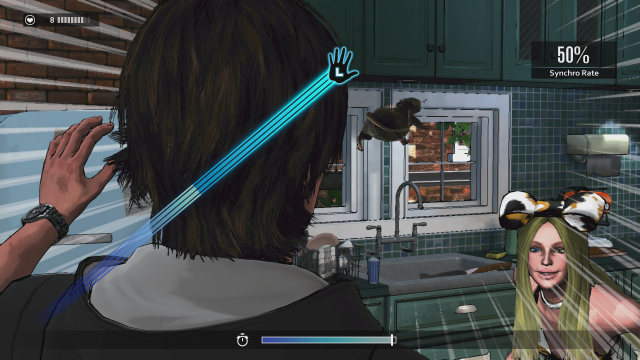UPDATE: While our review focuses on the original Xbox One version of D4: Dark Dreams Don’t Die, we have added an additional section to deliver impressions of the belated PC version.
D4: Dark Dreams Don’t Die is a bizarre exercise in quirkiness and intrigue. It’s also far and away the Xbox One’s weirdest and most memorable exclusive of 2014.
Coming to us from the mind of Access Games’ Hidetaka “SWERY” Suehiro, the mastermind behind last-gen cult hit, Deadly Premonition, considered to be the most critically polarizing game of all time to date, D4 is unlike anything else on Microsoft’s new console. If you were put off by Deadly Premonition’s overstuffed, oddball set of mechanics, D4 is at least more accessible and polished than SWERY’s previous major project, even going as far as to be directly published by Microsoft this time. Bear in mind however that the game isn’t inclined to root itself any further in reality. If anything, it’s even more insane than Deadly Premonition in several spots!
Like Deadly Premonition however, you can’t accuse D4 of being uninspired, and that will definitely make it a draw for people who are eager to play something different. The game even builds itself around the Xbox One’s Kinect sensor pretty well (though you can still play it with a controller if you don’t have an Xbox One Kinect, or simply prefer not to use it in your games), and makes for an experience that, while proudly offbeat, sets the stage for a new episodic mystery game series in an effective, fun fashion.
Those who prefer conventional Xbox gaming will probably find D4 to be too weird and scant to create any kind of satisfaction, but if you have a true sense of gaming adventure, this is a game that Xbox One gamers simply must experience for its sheer uniqueness alone!
Deadly Premonition may have appeared dated and ugly by the standards of its initial release in 2010, and especially by the time its ‘Director’s Cut’ came around in 2013, but D4 is another story. While there are still some blemishes, D4 has noticeably more visual polish, and leaps off of the screen with its vibrant, cel-shaded and comic book-esque style.
The game further comes to life thanks to some delightful cartoon animation that ranges from absurdly funny to stomach-turning. It has all of the insanity of many brands of Japanese anime, but also undeniably borrows from hard-boiled Western graphic novels. It’s a great blend of styles that gives D4 its own unique flavour, helping it stand apart from just about anything else on the Xbox One, and just about any other platform for that matter.
There also seems to be a mite of inspiration taken from the highly successful episodic adventure games made by Telltale in terms of both looks and performance, only with more of a Japanese touch. Thankfully, the technical glitches that sometimes drag down Telltale’s efforts are nowhere to be found in D4, likely a benefit of Microsoft directly taking on publishing duties.
The game runs pretty well overall too. There are instances of slow-motion when players have to input button combinations or gestures, depending on whether they’re using a controller or Kinect, but even when players are constantly moving their hands to wave the cursor around myriad interactive objects with Kinect during normal gameplay, D4 never chugs or crawls in terms of its performance. This makes it another technical far cry from the far patchier Deadly Premonition, which had a pretty bad framerate that liberally slowed to a crawl at the slightest provocation on any of its platforms.
While the graphics won’t ultimately floor you, they do make great use of the Xbox One’s technical prowess, and provide a game that is eye-catching and fun to watch, even for those not directly playing it.
D4 has a huge mix of musical styles that provide a little something for everyone. Naturally, the music doesn’t skimp on a sense of kooky adventure either. The small inspiration of upbeat 80’s television drama themes to book-end episodes is also an interesting touch, and like so many other offbeat design elements of D4, works better than you might think.
As for the sound effects, they’re exaggerated and brash, no doubt feeling right at home in your usual Japanese anime. As much as the dialogue aims to be serious and dramatic, the sound effects are anything but, placing the game in the usual sort of weirdness that one can expect from SWERY, especially during the action sequences. At its strangest, D4 could practically pass as a slapstick cartoon, with sound work that is so intentionally overdone that you can’t help but chuckle at it, even in an otherwise serious murder mystery story.
The voice acting however is more serious and grounded, and very well-done. David Young is a more down-to-earth protagonist than Francis “York” Morgan from Deadly Premonition, even if he still manages some funny quips, especially if players opt to make him more of a smart-ass during branching dialogue choices. The other characters range from melancholy to outrageous, but all of them are wholly memorable. Whether it’s David’s gluttonous detective partner, Forrest Kaysen, his mute freeloading cat-like roommate, Amanda, an avant-garde fashion designer with a romantic attachment to a mannequin, a hard-nosed U.S. marshal with a bad attitude, a panicky, psychiatrist-obsessed airline passenger, or a flamboyant male flight attendant with a suspicious inhaler, everyone in D4 is great to listen to and impossible to forget, which is often a big strength in SWERY’s works.
The audio has the same increased polish and clarity, not feeling mismatched and poorly-mixed, as it often was in Deadly Premonition. Again, it probably comes from Microsoft directly publishing, and obviously wanting a more polished Xbox One exclusive from D4, but the result is a varied and ambitious audio job that, like the visuals, is very quirky, and ends up all the more appealing for it.
D4 is a mystery game that has players using David Young’s unique ability to warp through time. While the game still mostly proceeds in a linear fashion, similar to the Telltale games, or the narrative-driven PlayStation games by Quantic Dream, you can move back and forth between David’s apartment, and a commercial airliner that disappears after a mysterious lightning strike.
Like Microsoft’s Killer Instinct revival from the Xbox One’s launch, D4 aims to try and combine a television-based model with a video game project, only unlike Killer Instinct, D4 obviously isn’t free-to-play. The game is currently in, “Season One”, which comprises a prologue, and two episodes. The prologue helps to introduce you to the premise and mechanics, while the next two episodes have David moving between his apartment and the airliner, trying to move through time to solve the murder of his wife, Little Peggy.
Originally, D4 was meant to be a Kinect-only game, though shortly before release, support for the Xbox One’s controller was apparently put in. The game’s Kinect inspiration is very evident throughout though, with even movement having to be done in a point-and-click style, and branching dialogue choices able to be spoken directly with the player’s voice.
While Kinect often gets a bad rap amongst gamers, D4 is actually one of the better Kinect games available on Xbox One. The sensor generally does a good job of responding to your gestures, only rarely failing to recognize arm movements during action sequences and the like. As long as you’ve placed the sensor well, and aren’t sitting too close or too far from it, you should have no issues playing D4 with Kinect, which is generally pretty smooth and reliable.
The only time that Kinect trips up a bit is in the enormous amount of things that players can interact with at any given point in D4. There are times where the game will get confused and not recognize what you want to interact with properly, though as long as you move your hand carefully, you shouldn’t have too many problems. You also need to make a fist to actually affirm a selection, which helps to minimize accidental interaction with Kinect, and while leaning will move the camera around, you have to lean pretty far to trigger this function. Kinect also pretty consistently recognizes your voice during branching dialogue to boot, only really tripping up when it comes to words with silent letters that the game seems to want you to say in some strange pitch.
Where the Kinect play is at its best however is during the handful of action scenes. These are disappointingly rare, with about one or two per episode, but they definitely make the best use of the Kinect’s motion-tracking capability. With thrusts and waves of your arms, as well as occasional contextual actions like pulling an arm back, punching, or even shouting, D4 brings you into the ridiculous action with the kind of incredible immersion and fun factor that a controller just can’t replicate as effectively. Again, there are rare instances where the sensor will flub an arm movement, but even Xbox gamers who normally hate Kinect will probably have some good fun engaging in the action beats of D4 with the sensor.
Again though, if you don’t own the Xbox One’s Kinect sensor, or stubbornly refuse to use it, everything, including the action scenes can still be done with the controller. Controller interaction works well enough, with players able to simply use the thumbsticks to highlight options, and the A Button to select things, using Y whenever they need to engage Detective Mode-style vision that highlights points of interest, which you do by opening your hands on placing them on your forehead when playing with Kinect. The controller works about how you’d expect it to, and during passive gameplay, some players may prefer it, since moving the hand cursor with a thumbstick amounts to less confusion when interacting with the numerous points of interest in the game.
The controller is pretty clunky during the action sequences though, and while using it will avoid misinterpreted gestures, getting ‘Perfect’, or even ‘Great’ ratings, is virtually impossible with certain button combinations, especially since the game tries to compensate with very picky timing when you shirk Kinect, as if the game wants to punish players who can’t or won’t use Kinect. Most of the action sequences are done with the controller by flicking the thumbsticks, pressing in the triggers, and occasionally mashing a face button. which is not only less fun than the Kinect gestures, but surprisingly even less reliable. There will never be an instance where the controller just flat out won’t work, but if you’re an achievement hunter that wants strong ratings in the action scenes, you’ll have a much easier time using Kinect.
Fortunately, you can easily switch between Kinect and the controller at will during gameplay, as long as it’s not an action scene. Pressing and holding any button on the controller will switch from Kinect controls to controller controls, while holding your arms up for a few seconds when playing with a controller will do the opposite, assuming you have your Kinect sensor plugged in, obviously.
Regardless of your preferred control method, D4’s debut ‘season’ will span about 3-4 hours of gameplay. This might seem rather short for a $14.99 game on the Xbox One Games Store, but D4 compensates by being very nicely replayable. The game is packed with achievements, almost 80 achievements to earn for the full 1,000 Gamerscore in fact, and has all sorts of nifty side distractions hidden throughout it.
Whenever you want to take a break from the mystery, you can warp back to David’s apartment to buy new outfits with any Credits you earn, which are given for investigating thoroughly, and solving the game’s mysteries and side tasks. Talking with certain characters will give you side cases, which can amount to minigames, trivia challenges, or treasure hunts, among other things. These side cases give you a few more Credits and outfits for both David and the other characters, as well as awarding more of the game’s many achievements.
Thus, it’s to your benefit to take your time and poke and prod at just about anything in D4. The game is packed with cool secrets, hidden little bits of humour, especially when you hover your cursor around a point of interest for a few seconds to see David’s thoughts, and little collectibles, such as scrapbook portraits and letters from Little Peggy. The collectibles and outfits are pretty pointless, and almost aim to satirize redundant video game collectibles, but at least they’ll keep achievement hunters and completionists busy for a little while.
In typical Access Games fashion however, you can’t just explore around willy-nilly all the time. For whatever reason, David has some kind of severe, unmentioned hypoglycemia, causing even mundane tasks like opening doors and picking things up to eat up Stamina, which can be replenished by buying and finding food to eat. Food also serves as another collectible of sorts, since the game awards you achievements for eating all of the different types of food available in D4. When your Stamina depletes, David will collapse, and it’s Game Over, forcing the player to either go back to David’s apartment, or spend 1,000 Credits to be dropped back where they were. The game autosaves anyway though, so you might as well just go back to the apartment and return to the bathroom to warp back to where you were and save the Credits. Perhaps it’s another clever way that D4 aims to mock and punish lazy players.
Fortunately, losing yourself in D4 and wanting to take your time discovering all of its little oddities isn’t all that difficult. The main story itself might be a little short-lived at this point, but hopefully more great content is set to come later. What’s already here is addictively strange and uniquely rewarding, especially in how little D4 has in common with just about any other Xbox One gameplay experience.
Unfolding in an episodic style that echoes 1980’s television dramas, yet another seemingly erratic thing that D4 adds to its potpourri of eccentric inspiration, the game puts players in control of private investigator, David Young. David’s wife, Little Peggy was murdered under mysterious circumstances, and the trauma of the event has somehow given David the ability to travel backwards in time and space. Using ‘Mementos’, items that bring David back to key moments in history that relate to David’s investigation, David is haunted by his wife’s final words, “Look for D.” Thus, this first season’s worth of episodes is all about discovering who ‘D’ is, and why Little Peggy was killed.
The storyline of D4 is naturally strange and unpredictable, and takes some radical SWERY-approved hard lefts into abstract strangeness. This helps to keep the story interesting, even if it’s pretty far removed from reality. It’s unsurprising then that the game’s story heavily factors in a dangerous red powder narcotic known as, “Real Blood”, which may be connected to Little Peggy’s murder.
D4 is a game that is best enjoyed when you don’t exactly know what you’re in for, so that the game’s weirdness can effectively take you along on a strange, yet enjoyable ride through one of the most oddball murder mysteries you’ve ever experienced. The only drawback of what’s otherwise a pretty enjoyable, albeit strange mystery story in fact is that D4 ends its final Season One episode on a rather frustrating cliffhanger, leaving no resolution at all, and stopping right at a key moment that just feels like a big, fat tease for another bit of content that apparently hasn’t even entered active development yet.
The joy of discovery is often present throughout D4 leading up to its annoying conclusion however, at least, so long as you have a tolerance for Japanese-style strangeness. If you’re willing to venture off of the beaten narrative path though, and enjoy mystery stories that aren’t afraid to veer off into weird territory, you’ll be in for a story that will hook you in all of its offbeat glory, and leave you eagerly anticipating more.
SWERY may be adamantly against a PS4 version of D4: Dark Dreams Don’t Die at this point, but he did make good on his promise to release a belated PC port. Better still is that the PC version of the game is pretty good too, especially if you can get it at a discount during a Steam Sale, or something of the sort.
Despite originally being designed around the Xbox One’s Kinect, D4: Dark Dreams Don’t Die handles pretty well with a mouse and keyboard. Mouse movements during action sequences add the perfect balance between the increased precision of a controller, and the more free-form movement of the Kinect, which is a choice that players have to make with pros and cons to weigh in the Xbox One version. You can still play D4: Dark Dreams Don’t Die with a gamepad, and if you use an Xbox One controller, you get pretty well the same experience as playing the Xbox One version on your computer, but the mouse and keyboard controls definitely feel ideal. This is on top of the fact that the game looks great on PC as well, and on optimal settings, it does get a small visual boost over its Xbox One predecessor.
With that said however, the same eccentric gameplay, frustratingly short length, and very vague, off-the-wall storyline are obviously still a factor that would-be players must consider if they’re thinking of purchasing the PC version. There’s no additional gameplay content over the Xbox One version, meaning that the game still feels like it ends prematurely. Still, if you appreciate unique gameplay experiences that aren’t like anything else, and haven’t already gotten your hands on the Xbox One build, D4: Dark Dreams Don’t Die holds up very well in its migration to PC.
D4 feels inherently incomplete at this point, but what is here is an appealing slice of eccentric game design with more polish and accessibility than the polarizing Deadly Premonition ever had. Whether you opt to play with the controller or Kinect, or a mix of both, the game tells a strange, yet compelling mystery tale that gives you plenty of interesting things to interact with, and a surprisingly extensive list of collectibles and challenges that will help to keep you busy, compensating somewhat for the very brief initial story. If nothing else, it can be pretty funny too, despite the outwardly serious subject matter.
You can power through D4 in just over three hours if you’re really fast, but this isn’t the kind of game that you aim to play through quickly. The game rewards you for taking the time to bask in its weirdness, even if its rewards are equally weird. In a strange way though, the open satirizing of modern game mechanics for things like a food roster or a bunch of ridiculous outfits, remains no less rewarding, motivating players to run with the offbeat gameplay, and try to push the odd presentation as far as they can in a quest for more redundant, offbeat achievements that aggressively defy current gaming convention.
Maybe in some respects, D4 is a game built around open defiance of what is considered to be a recipe for a good game in this day and age, especially on an Xbox platform. To those seeking a welcome breath of fresh air from the glut of gritty shooters and vain sports sims though, D4 grants you something that stands fully apart from anything else on the Xbox One. It’s not the best game on the console at this point, but it’s not trying to be. It’s trying to be different, but not so different that nobody can enjoy it.
If you’re not afraid of different, or perhaps downright inverted from common sense, D4 will intrigue you and provide you with plenty of smiles. Hopefully the rest of the experience can be realized soon.

